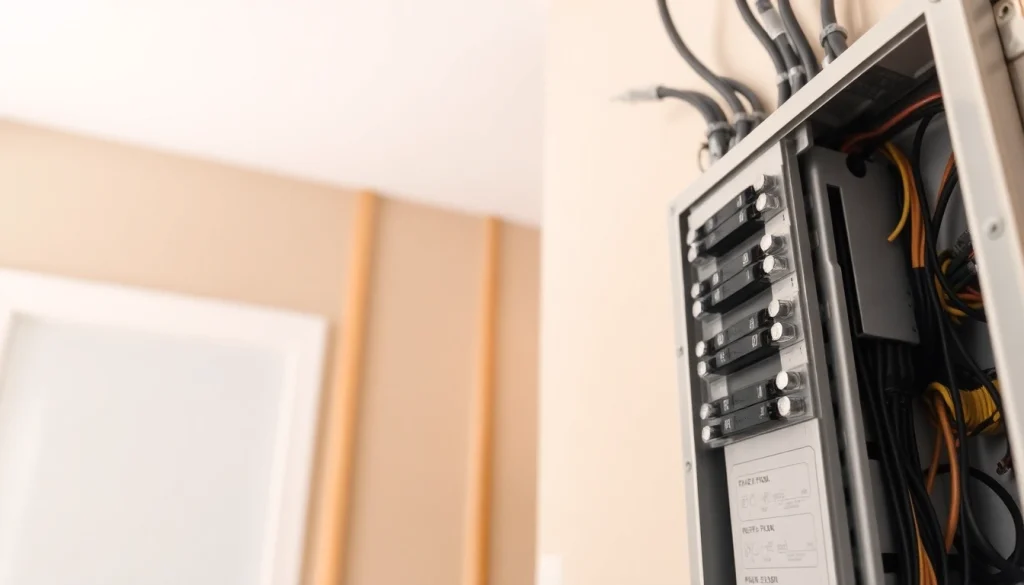Understanding the Electrical Panel
The Electrical Panel serves as the heart of your home’s electrical system, acting as a central hub that distributes electricity throughout your residence. Whether you’re powering essential appliances or charging your devices, the electrical panel plays a critical role in ensuring everything runs smoothly and safely. In this article, we will delve into the different aspects of electrical panels, ranging from their essential functions and components to signs indicating when an upgrade may be necessary, and benefits of modernization.
What is an Electrical Panel?
An electrical panel, often referred to as a breaker box or service panel, is a metal box that houses circuit breakers or fuses. It receives power from the utility company and distributes it to various circuits within a home. This essential component controls the flow of electricity, ensuring that each circuit gets the appropriate amount of power while providing protection against electrical overloads and shorts. The electrical panel serves multiple purposes, including:
- Power Distribution: It ensures that electricity is distributed efficiently across various circuits, providing power to outlets, lights, and appliances.
- Overload Protection: Equipped with circuit breakers, the panel prevents overload situations by automatically shutting off power to the affected circuit.
- Centralized Management: Homeowners can centralize the management of their electrical needs—from turning off electrical devices to resetting tripped breakers.
Common Types of Electrical Panels
Understanding the types of electrical panels can help homeowners make informed decisions about upgrades or replacements. The most common types include:
- Main Breaker Panel: This is the primary electrical panel that connects directly to the power meter. It’s responsible for distributing electricity to the house and managing multiple circuits.
- Sub-Panel: A sub-panel is an additional panel that extends the existing electrical system. It’s typically installed for larger homes to manage electricity in separate areas, such as basements or garages.
- Load Center: This is another term for a service panel, designed to house circuit breakers that protect the electrical circuits.
- Smart Panels: Modern technology has birthed smart electrical panels, enabling homeowners to monitor and control their energy usage via connected apps.
Components and Functions of Electrical Panels
The effectiveness of an electrical panel stems from its various components, each designed to perform crucial functions:
- Circuit Breakers: The most recognizably important component, circuit breakers monitor the electrical load. When the load exceeds a designated limit, they trip, stopping the flow of electricity and protecting the circuit.
- Bus Bar: This is a metal strip that distributes electricity from the incoming line to the individual circuit breakers.
- Main Breaker: This large breaker controls the entire electrical supply to the panel. It allows for the entire system.
- Neutral Bar: This connects the neutral wires from various circuits back to the panel. It ensures the safe return of electricity to ground.
- Enclosure: The metal casing protects the internal components and serves as a grounding mechanism.
Signs That Indicate It’s Time to Upgrade Your Electrical Panel
Homeowners should remain vigilant regarding the performance and age of their electrical panel. Here are signs that may suggest an upgrade is necessary:
Frequent Circuit Breaker Trips
One of the first signs of an overburdened or outdated electrical panel is frequent circuit breaker trips. While occasional tripping can be normal, consistent breaker trips indicate that the panel may be struggling to handle current electricity demands. Continuous tripping may lead to a total shutdown, risking safety and device damage.
Age of the Electrical Panel
The age of your electrical panel should not be overlooked. Most panels have a lifespan of around 20 to 30 years. If your panel is older than this, it may not meet the energy needs of modern homes or the latest safety standards. Older panels may also lack essential safety features such as ground-fault circuit interrupters (GFCI) and arc-fault circuit interrupters (AFCI).
Growing Electrical Needs
As your household grows or as you add more electronic devices, your electrical demands may outstrip your panel’s capacity. High consumption devices like AC units, electric vehicles, and extensive home entertainment systems require an upgrade to meet safety and performance standards. If you find yourself constantly adding circuits or exceeding your current capacity, it may be time to consider an upgrade.
Benefits of Upgrading Your Electrical Panel
Investing in an upgraded electrical panel can offer numerous advantages, enhancing safety, efficiency, and the overall value of your home:
Improved Safety Standards
Modern electrical panels are designed with numerous safety features that are often absent in older units. Newer panels use superior materials and construction techniques to minimize fire hazards, reduce the risk of shock, and prevent overloads. Enhanced safety standards also make your home more compliant with national electrical codes.
Enhanced Energy Efficiency
As technology advances, electrical panels have also evolved to become more energy-efficient. An upgraded panel can lead to lower electricity bills, as they better regulate the energy flow and reduce energy waste. With the incorporation of smart technology, homeowners can actively monitor their energy consumption, making informed adjustments to enhance savings further.
Increased Home Value
Having a modern, efficient electrical panel can elevate the resale value of your home. Potential buyers view updated electrical systems favorably as they promise reduced maintenance costs and improved safety. An upgraded electrical panel showcases that home is well-maintained and aligns with modern electrical demands.
Choosing the Right Electrical Panel
When it’s time to choose a new electrical panel, there are several factors to consider to ensure the best fit for your home:
Understanding Amp Ratings
Electrical panels come in different amp ratings, such as 100, 150, or 200 amps. The appropriate amp rating for your home will depend on your electrical consumption needs. A 100-amp panel is standard for smaller households, while larger homes or those with high electricity demands may require 200 amps or more. Consult a professional to evaluate your needs and recommend the right size.
Customization Options Available
Today’s electrical panels offer customization options based on individual needs. Homeowners can tailor their panels to accommodate various circuit requirements, such as allocating dedicated circuits for high-power appliances. Features like surge protectors, sub-panel options for specific areas, or smart technology integration can all be considered when upgrading.
Professional Installation vs. DIY
While some may consider a DIY approach for replacing an electrical panel, it is highly recommended to hire a licensed electrician. Professional installation ensures compliance with local codes and standards, reducing risks associated with improper installation. Furthermore, professionals can conduct a thorough safety inspection and ensure that the panel is correctly matched to your electrical needs.
Maintenance Tips for Your Electrical Panel
Maintaining your electrical panel extends its lifespan and enhances safety. Here are some essential maintenance tips:
Regular Inspection Practices
Routine inspections of your electrical panel can help identify potential issues before they escalate. Periodically check for rust, corrosion, or heat damage. Look for signs such as burning smells, discoloration, or any physical deformation of the panel. If any issues are detected, seek professional advice immediately.
Signs of Wear and Tear
Beyond general inspections, homeowners should watch for specific signs of wear and tear, such as:
- Continuously tripping breakers
- Flickering lights or inconsistent power supply
- Burn marks or discoloration around breakers
- Excessive heat emanating from the panel
Each of these symptoms denotes that intervention may be necessary to prevent potential dangers.
Safety Precautions During Maintenance
Always take safety precautions when inspecting your electrical panel. Ensure the main power is turned off before conducting any visual checks. Avoid touching any wires or components unless you are a qualified electrician. If in doubt, consult a professional to handle any electrical maintenance.





